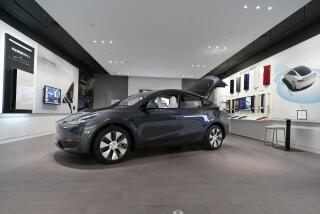Q&A with Ford CEO Mark Fields

Most car company executives appear at the annual Los Angeles Auto Show to tout their brand’s new vehicles or crow about its balance sheet.
Ford Chief Executive Mark Fields came to town this year to give the kick-off keynote speech at AutoMobility L.A., the industry-only portion of the massive car show, and didn’t discuss those things at all.
For the record:
12:55 p.m. April 19, 2024An earlier version of this story identified the hydrogen fuel cell Clarity as a Ford vehicle. It is made by Honda.
Instead, he talked about the future of mobility, the “city of tomorrow” and how Ford is trying to find its place in a changing transportation landscape that — confronting autonomous driving, connected cars and ride-sharing — may soon have no place for traditional car companies.
The following is an edited version of the conversation.
Ford produces the F-150 truck, the most popular vehicle sold in America, but is also offering a line of hybrids and plug-in hybrids. How important is electrification to the future of the American car industry?
Right now the industry has 60-plus electrified vehicles on the market, and that represents about 2.5% of sales. If you go back seven or eight years ago, the industry had about 12 electrified vehicles on the market, and that represented about 2.5% of sales. So, getting individual buyers interested in electrification is a challenge — both in overcoming the cost hurdles and in getting people used to electric. Obviously, they have reservations about cost — which is a legitimate concern — but they also have range issues and anxiety around charging. As an industry we have to address that.
We know that all car companies are thinking about autonomous vehicles, and that Ford has a research and development office in Silicon Valley. Yet compared with Tesla, with its Autopilot self-driving system, or GM, with its plan to begin using autonomous vehicles in partnership with the ride-hailing company Lyft, Ford has been quiet in this area. What’s on the burner?
When we look at autonomous vehicles, the challenges really revolve around making sure the technology develops — both the hardware and the software — making sure the regulatory environment comes along, and making sure the economics around the new technologies are such that people can afford that. Our intent is to have a fully autonomous, level four vehicle — a vehicle that does not have a steering wheel or accelerator pedal, where the passenger does not ever have to take control — in the market by 2021 as part of a ride-sharing service.
How do you do that? Tesla’s least expensive Autopilot-enabled car costs more than $70,000. How do you make autonomous vehicles affordable?
When we talk about the “city of tomorrow,” and we look at the issue of mobility and the cost of mobility in urban areas, we see that when you take the cost of the driver out of the ride-hailing service, it becomes more affordable. And when it becomes more affordable, people can use it more. What that means is a virtual driver system, which “sees” the road through different cameras and radars and sends the information to the individual autonomous vehicle platform. At its highest level, that is what we’re developing.
Ford has been aggressive about pursuing environmentally friendly solutions in the automotive space. You went all-aluminum on the F-150, dropping weight and increasing fuel economy; branded an electric bicycle in partnership with Pedego; and have found ways to recycle everything from cigarette butts to worn-out jeans into floor mats and seat cushions. Is your heart in the same place as your bottom line?
We are stepping back as a company and asking what is the world going to look like 10 or 15 years from now — and then understanding as a business what does that mean for us. We’re going to cities and working with them on their transportation and mobility issues, and asking how do we become part of that solution. You think about the various benefits, the societal ones, about handicapped or elderly folks who can’t get around anymore. Think about the safety facets. Last year in the U.S. there were more than 35,000 automobile fatalities. Even a small dent in that is a big deal. But even on those products we have been forward-looking, it needs to start with what the consumer is looking for. At the end of the day, we have to have products that people want to own and pay for.
charles.fleming@latimes.com





